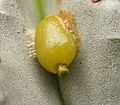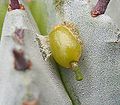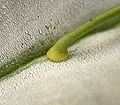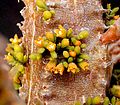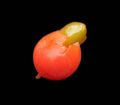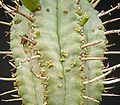Dwarf mistletoe
| Dwarf mistletoe | ||||||||||||
|---|---|---|---|---|---|---|---|---|---|---|---|---|

Dwarf mistletoe ( Viscum minimum ) |
||||||||||||
| Systematics | ||||||||||||
|
||||||||||||
| Scientific name | ||||||||||||
| Viscum minimum | ||||||||||||
| Harv. |
The dwarf mistletoe ( Viscum minimum ) is a species of mistletoe from the sandalwood family (Santalaceae). It is the smallest of all types of mistletoe.
Description and occurrence
The dwarf mistletoe is a succulent parasite that occurs naturally only on two closely related spurge species: Euphorbia horrida Boiss. and Euphorbia polygona Haw. Probably as an adaptation to its succulent hosts and the seasonally very dry and hot environmental conditions, the dwarf mistletoe lives almost completely inside the host plants. There it forms a network of interconnected haustoria , which in places breaks through the host's epidermis . The "twigs" that appear on the surface of the hosts are less than 3 mm long and have tiny scaly leaves that can only be seen with a magnifying glass. Because of the very limited possibility of its own photosynthesis , the species is a parasite , an endophytic holoparasite.
Contrary to some information in the literature, the dwarf mistletoe is monoecious . One and the same plant produces both purely male and purely female flowers. The male flowers are inversely conical, about 1.5 mm thick and 2.5 mm long, the female flowers are spindle-shaped, about two mm thick and three mm long. After fertilization , the ovary below the female flower swells and develops into a bright red colored berry fruit when ripe . The berries only contain one seed , which occasionally - as with the European white berry mistletoe - can contain two seedlings . The chewy, sticky juice that surrounds the seeds in the pulp is striking . This slime is important for the spreading to other suitable host plants.
The seeds are spread by birds , which eat the pulp and strip the sticky seeds off other plants. During germination, instead of the cotyledons, a tubular organ ( hypocotyl ) with a terminal disc is formed. If this disc meets the epidermis of a suitable host, a pointed, cone-shaped primary haustorium soon emerges from its center, through which the seedling penetrates the host plant.
The distribution area of the dwarf mistletoe is limited by that of their hosts. It extends in the Eastern Cape of South Africa from Uitenhage and Albany to the area around Willowmore .
The number of chromosomes is 2n = 28.
Germination of the dwarf mistletoe on Euphorbia horrida
Development of flowers and fruits of the dwarf mistletoe on a rooted branch of Euphorbia tubiglans
cultivation
The dwarf mistletoe, which occurs naturally only on the host plants Euphorbia horrida and polygona, can also be cultivated on other closely related spurge species from the subgenus Rhizanthium . These include a. Euphorbia anoplia , fimbriata , inconstantia , ferox , mammillaris , pillansii , pulvinata , submammillaris and tubiglans . The reason why these other species do not become infected naturally is not well understood. Presumably, a component of the milk juice produced in the natural environment represents a repellent against the parasite, which, however, cannot be produced or cannot be produced in sufficient quantities under culture conditions.
Alternatively, the dwarf mistletoe can also be propagated by cuttings from the host plants. Since the hosts mainly branch out close to the base, it makes sense to prepare this method of propagation to allow the parasite to grow in close to the base and to take the branches that have grown through the parasite as cuttings. The dwarf mistletoe and their hosts are well adapted to each other. Otherwise healthy host plants are not noticeably affected by the parasite for a few years.
As a rule, the "unnatural" hosts are not damaged by the parasite either. However, since this is an additional consumer of water and nutrients, it is advisable to water and fertilize the hosts adequately and not expect them to be extreme.
Since the dwarf mistletoe is self-compatible , the female flowers can be successfully pollinated with the pollen of the male flowers on the same plant. A few weeks after fertilization, the now swollen fruits turn bright red. If they become soft and slightly wrinkled in late winter to early spring, they are fully ripe and can be harvested.
As a new host, a plant that has already emerged a bit should be chosen, which already shows new growth in the apex. If the seed is placed there in the apex, the seedling will find a softer epidermis, which makes it easier to penetrate. Since the dwarf mistletoe mainly spreads downwards in later growth, this also ensures that it grows evenly through the entire host plant. After the seedling has "docked" through the primary haustorium, the parasite grows exclusively inside the host plant for a long time. It can take four to twelve months for the first twigs to become visible on the surface. If the germ tube including the adhesive disk has wilted in the meantime, this is not to be interpreted as a sign for or against a successful establishment of the parasite.
Examples of milkweed species on which the dwarf mistletoe can be successfully cultivated
literature
- William Henry Harvey: Flora Capensis 2: 581
- Robert Allen Dyer: Two Rare Parasites on Succulent Species of Euphorbia , Euphorbia Review Vol. I (4): 29-32, 1935
- Thomas Goebel: Viscum minimum Harvey in the succulent collection of the city of Zurich , cacti and other succulents 29 (1), 1978
- Frank K. Horwood: Two parasites of Euphorbia: Viscum minimum and Hydnora africana , The Euphorbia Journal, Vol 1: 45-48, 1983
Individual evidence
- ↑ Viscum minimum at Tropicos.org. In: IPCN Chromosome Reports . Missouri Botanical Garden, St. Louis
Web links
- Profile of the art. ( Memento from June 10, 2010 in the Internet Archive )
- The noble parasite: Viscum minimum Harvey. (PDF file; 542 kB)

